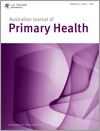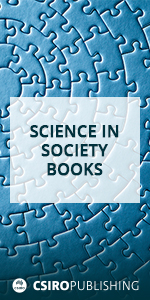
Australian Journal of Primary Health
Volume 26 Number 4 2020
Featuring abstracts of the Australasian Association for Academic Primary Care (AAAPC) Annual Research Conference, 14–15 August 2020
PYv26n4_EDCelebrating diversity and adaptability in academic primary care
PY20141Learning from COVID-19 to improve access to physiotherapy
Funding for telehealth should continue post-COVID-19 and should include provision for tele-physiotherapy. There are several instances where tele-physiotherapy may be an appropriate form of primary care, including the early management of acute pain, which may otherwise become chronic. By extending the availability of tele-physiotherapy beyond 30 September 2020, we can improve the health of the population generally and, in particular, better serve remote or otherwise isolated people.
PY20141 Abstract | PY20141 Full Text | PY20141PDF (84 KB) Open Access Article
Primary Health Networks (PHNs) are well positioned to improve access to integrated and coordinated multidisciplinary care to prevent and manage chronic pain in the primary care setting. This scoping review identifies the types of chronic pain initiatives in Australian primary care (and the supporting evidence) that can be implemented or commissioned by PHNs. Future commissioned services and other primary care initiatives should incorporate robust evaluations to help address the identified evidence gaps and allow for adaptation by other PHNs to address local health needs.
PY20092 Abstract | PY20092 Full Text | PY20092PDF (231 KB) | PY20092Supplementary Material (3 MB) Open Access Article
PY19216Cardiovascular disease risk assessment in an Aboriginal community-controlled health service: comparing algorithms
Indigenous Australians have high rates of cardiovascular disease (CVD) but are under screened for CVD risk. Two cardiovascular disease risk tools are available to determine risk of a cardiovascular disease event in Aboriginal and Torres Strait Islander Australians. This study adds urban clinic level data to the growing population level research in CVD risk assessment in Aboriginal and Torres Strait Islander Australians, by comparing the two available CVD risk algorithms, screening coverage and treatment in an Aboriginal Community-Controlled Health Service.
PY19119Visual impairment among Aboriginal and Torres Strait Islander patients attending an Australian Indigenous primary health service: a cross-sectional study
Early identification of preventable vision loss is essential to avoiding long-term effects on quality of life. This research investigated the frequency of vision loss among Aboriginal and Torres Strait Islander people attending an urban Indigenous primary healthcare service. We found a lower proportion (2.4%) of vision loss compared with the 2016 National Eye Health Survey Report (13.6%), which was more common in older adults, highlighting the importance of routine vision screening of Aboriginal and Torres Strait Islander people aged ≥60 years.
PY19119 Abstract | PY19119 Full Text | PY19119PDF (154 KB) Open Access Article
PY20084Quality and targeting of new referrals for ocular complications of diabetes from primary care to a public hospital ophthalmology service in Western Sydney, Australia
 , Lisa Keay, Blake Angell, Stephanie Hyams, Paul Mitchell, Gerald Liew and Andrew White
, Lisa Keay, Blake Angell, Stephanie Hyams, Paul Mitchell, Gerald Liew and Andrew White
Diabetic retinopathy (DR) is a leading cause of blindness, and moderate DR (or above) requires management with an ophthalmologist. However, public eye clinics have access blocks. High quality referrals are needed to make decisions regarding the urgency of patient care for ocular complications associated with diabetes. Primary care-initiated referrals are poorly targeted to tertiary care. To improve diabetic retinopathy screening and management, strategies should focus on education and feedback for primary care providers as well as integration of care.
PY19164Grey nomads with diabetes: the experience of rural and remote diabetes educators in South Australia
Grey nomads with diabetes may not be prepared or aware of services available to them while on the road. The research aimed to ascertain the experiences of diabetes educators in rural and remote South Australia. Insight into the problems experienced by the diabetes educators of this cohort were explored and further suggestions for improvement and further research were made.
The long-term benefits and risks of diabetes medications in older people are uncertain. Over 7-years follow up, older people on insulin or other oral hypoglycaemic/s compared with metformin-only were at increased risk of hypoglycaemia, cardiovascular disease and death. Findings raise questions about treatment intensification with second-line diabetes medications in older people.
PY20030Middle-aged Australians’ perceptions of support to reduce lifestyle risk factors: a qualitative study
 , Elizabeth Halcomb
, Elizabeth Halcomb  , Susan McInnes
, Susan McInnes  , Karin Robinson, Elizabeth Lucas, Susan Harvey and Sarah Remm
, Karin Robinson, Elizabeth Lucas, Susan Harvey and Sarah Remm
Primary care practitioners play a pivotal role in identifying chronic conditions and health promotion, yet little is known about how consumers perceive their role in providing support to achieve healthy lifestyles. This study identified a lack of consumer knowledge about roles of health professionals; suggested gender differences in relation to seeking health advice; and indicated that lifestyle risk discussions were perceived as often being opportunistic rather than planned. Findings indicate that programs and information promoting healthy lifestyles need to be flexible and adaptable to maximise their effect.
PY20013‘I’m over the moon!’: patient-perceived outcomes of hepatitis C treatment
Narrowly defining hepatitis C virus as a medical condition, with the potential for liver and extrahepatic disease at some point in the future, may not encourage patients to initiate and continue hepatitis C treatment. This study aimed to report patient-perceived outcomes of receiving treatment for hepatitis C. Apart from physical health, patients expect and experience various outcomes, which are related to psychological and social aspects of living with, and being cured of, hepatitis C virus. Emphasis on the outcomes that are valued by patients may improve hepatitis C treatment uptake and adherence rates.
PY19247Using the Tailoring Immunization Programmes guide to improve child immunisation in Umina, New South Wales: we could still do better
National and state policies recommend strategies to improve childhood immunisation rates in areas of low coverage, regardless of financial or geographic barriers. Using a social model of health, this study examined factors influencing childhood immunisation on the Central Coast, New South Wales and found that socioeconomic factors, poor service accessibility and under-utilisation of data and reminder systems were associated with under-immunisation. Findings can help in the planning and delivery of supportive primary health care that includes equitable access to immunisation
PY20011Commissioning for health and community sector reform: perspectives on change from Victoria
Commissioning involves planning, purchasing and monitoring services. To address a range of issues in mental health community support and alcohol and other drug treatment services in Victoria, Australia, the state government embarked on system reform coupled with a commissioning process. This study demonstrates that limitations to planning and design work can result in commissioning becoming over-reliant on competitive tendering to produce results, create significant costs to services and engender system-level issues, potentially disrupting innovative models of care focused on meeting client needs.
PY20011 Abstract | PY20011 Full Text | PY20011PDF (123 KB) Open Access Article
PY20010HealthPathways: a detailed analysis of utilisation trends in the northern Sydney region
HealthPathways is an online tool that supports primary care providers to adhere to evidence-based care and referral guidelines. We developed a model for using Google Analytics data to evaluate HealthPathways usage and present the most detailed analysis of HealthPathways usage to date. HealthPathways is increasingly being adopted in clinical practice; in order to maintain this momentum and ensure that the content is meeting the needs of primary care providers, evaluation should be an ongoing effort.
PY19233Patient-centred method to evaluate the spatial accessibility of primary health care in a case study in Shanghai
This study quantified the spatial accessibility of primary health care (PHC) from the patient perspective. In Shanghai, residents took approximately 13 min to reach the nearest PHC facility, with an approximate 23 min wait to receive care after arriving. Therefore, the spatial accessibility of PHC in Shanghai is approximately 36 min, and the regional accessibility of PHC is much better than its regional availability. Relevant managers should focus on increasing the resource supply capacity of existing PHC facilities in Shanghai’s suburbs.
PY19233 Abstract | PY19233 Full Text | PY19233PDF (1006 KB) Open Access Article



